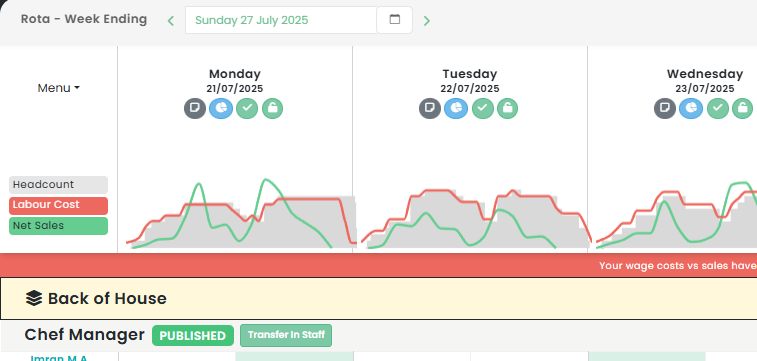KPIs for your restaurant or bar – what should you be managing?
Stay informed with industry news, tips, and practical guides for hospitality professionals.
Restaurant KPIs - where do you start?
This is both a simple and a complicated question at the same time… Monitoring Key Performance Indicators (KPIs) is vital for you to be able to track how well your business is performing and optimize your spending! There isn’t a one size fits all solution here, but read on to find out about some KPIs that you should be taking the time to look at!
There are many factors to consider when choosing which KPIs you should be using to manage your hospitality business. These include:
- Size of business (square foot)
- Number of employees and areas of the business (i.e. multiple kitchens or areas)?
- Turnover
- Location
- Type of trade – in trade, takeaway, delivery, events
…and yes, there’s many more than this too!
So, let’s start at the beginning. You have a restaurant and want to analyse its performance through KPIs. You keep googling restaurant KPI examples and get nothing useful. You could look at:
- SALES
By area – i.e. outside vs inside, upstairs vs downstairs
- This will help you see what physical parts of your business are doing well and which need improvement. For example, if you have an events room, setting the revenue of this room as a KPI will help you monitor what level of business this square footage of your business is bringing you.
By time – i.e. lunch vs dinner
- Not only will this give you an indication on where you need more staff and resource, it will also show you what times of the business you are most busy and what times you can optimize with marketing to increase sales.
By spend per head (SPH)
- Analysing your spend per head will show you how optimal your pricing is vs your customer profile. Please be careful when looking at your customers’ spend per head as there are other factors than can influence this – i.e. any promotions or offers you have on, any marketing pushes, any specific menus you have in place. Your restaurant may have an early dinner / theatre menu on offer with a lower price point which you have put in place to get the restaurant busy before a dinner service, but this sort of offering may lower your spend per head. Your dinner service may have a higher spend per head especially if you have premium wines on the menu and less discounts or offers.
- LABOUR
- the most important variable and controllable cost in your business, your labour cost is the one you should be focusing on pretty much on a daily basis. Over or under scheduling staff can have serious impacts on your business.
- You can look at various KPIs based on labour, some of which are listed below:
- Total gross pay (including NI and pensions)
- Total pay vs sales %
- Hourly sales vs labour %
- Forecasted vs actual labour (i.e. rota vs clock in times)
- Unauthorised absence, sick pay or leave as well as consistently late employees.
- Number of employees can also be a good KPI if you have a regular trade with the majority of staff on salaried (fixed wages).
These are just a few examples of how you could analyse your business on a daily and weekly basis.
What is my main KPI for my restaurant?
We believe Opsyte can help you analyse these KPIs, plus lots more. We have created our portal with an operator’s hat on and our plug and play analytics can give you instant access to vital data!
Please give us a ring if you would like to know more.
Ready to simplify hospitality ops?
We’ve got you.
Speak with an Opsyte expert to see how we help:
- Save hours on staff scheduling and rota planning
- Automate invoice processing and financial insights
- Track live labour costs vs sales in real-time
- Get fast answers and support from real humans
- Automate your P&Ls

“Opsyte transformed our entire back office. Game changer.”
Read articles from our hospitality experts
-
Maximising Efficiency in the Food Industry: The Comprehensive Guide to Restaurant Catering Software and Other Technological Solutions for Your Business
Unlocking Efficiency in Catering: The Need for Restaurant Catering SoftwareIn today's highly competitive UK hospitality landscape, efficiency and precision are paramount. With the increasing demand for seamless food service, restaurant…...
-
Boost Your Pub Business: Comprehensive Guide on Digital Marketing and Customer Engagement in the Hospitality Industry
Expert Strategies for Marketing Pubs in the UK Hospitality IndustryThe UK hospitality industry, particularly the pub sector, has witnessed tremendous changes over the years. Amidst this evolution, the importance of…...
-
Optimising Hospitality Industry Efficiency: The Comprehensive Guide to Staff Scheduling Software for Streamlined Rosters, Labor Cost Control, and Enhanced Employee Productivity
Optimise Your Hospitality Business with Staff Scheduling SoftwareIn the dynamic world of the hospitality industry, efficiency and productivity are critical factors that can determine the success of your business. This…...
-
Maximising Restaurant Productivity: Harnessing the Power of Online Restaurant Scheduling Software and Other Digital Management Tools
Revolutionising UK Hospitality with Online Restaurant Scheduling SoftwareThe UK hospitality industry is an ever-evolving landscape, continuously adapting to new trends, customer behaviours, and technological advancements. One such revolutionary trend...
-
Maximising Profits in UK's Hospitality Industry: A Comprehensive Guide to Restaurant Financial Management and Revenue Growth
Understanding Restaurant Profit Margin in the UK Hospitality IndustryThe UK restaurant industry is a dynamic and vibrant sector that is constantly evolving. It is a key component of the broader…...
-
Maximising Efficiency in the Hospitality Industry: Exploring the Revolution of Invoice Management in Restaurant Operations
Embracing Digital Innovation in the UK Hospitality Industry: Streamlining Restaurant Billing and Invoice ManagementIn today's digital era, the UK hospitality industry is witnessing a significant transformation. The restaurant business, a…...
